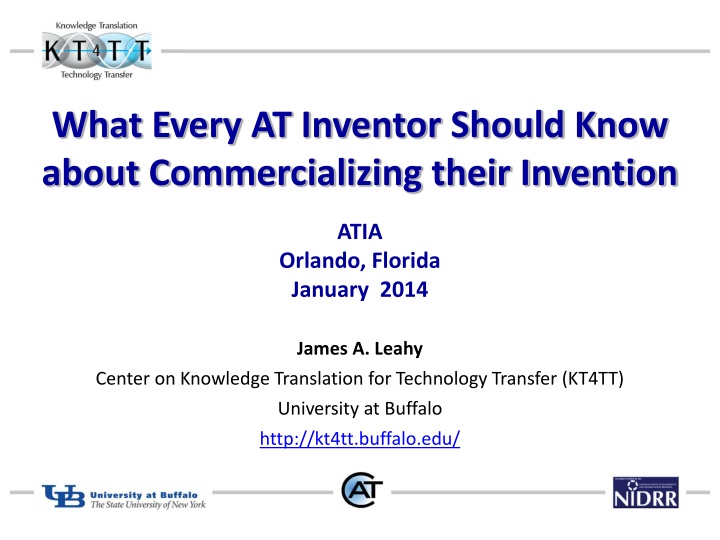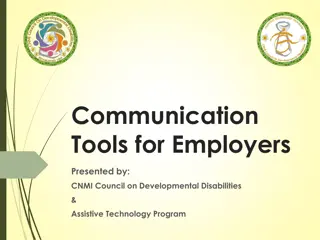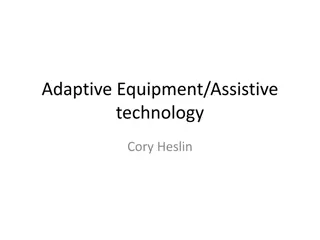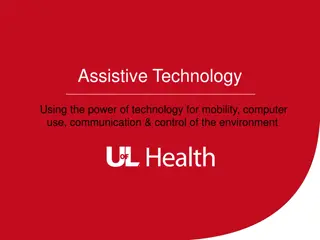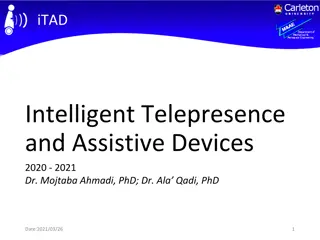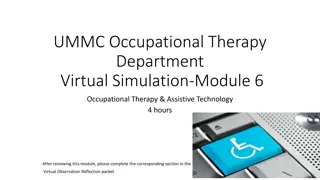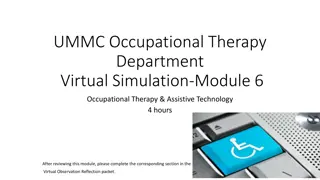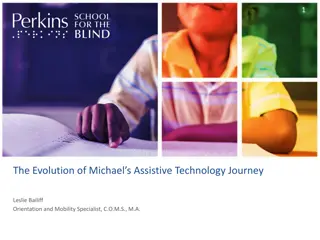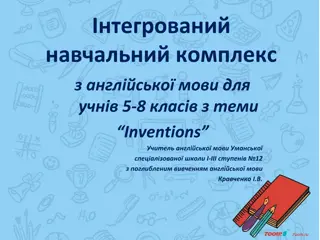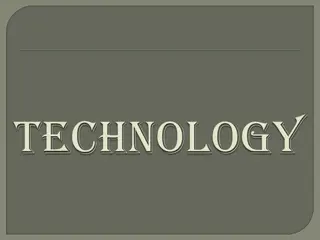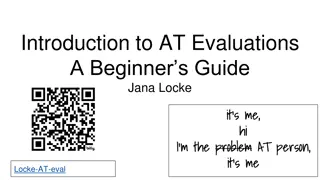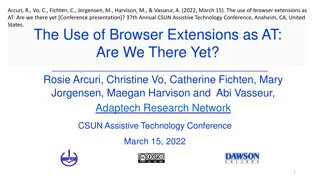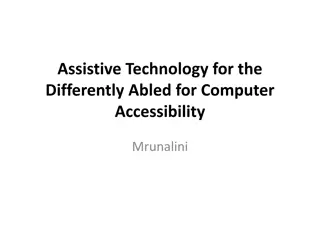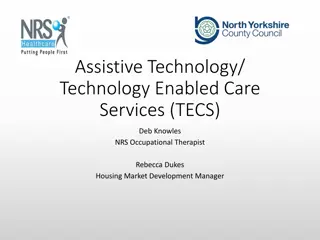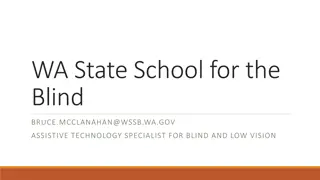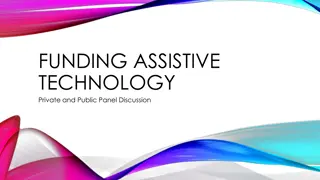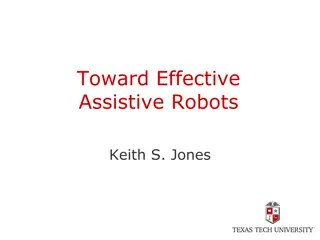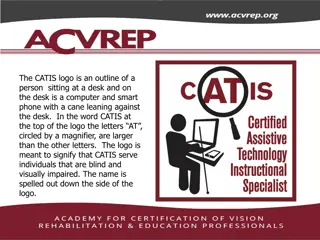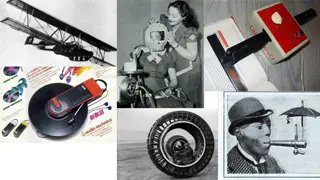Essential Strategies for Commercializing Assistive Technology Inventions
Discover key elements and strategies to successfully commercialize assistive technology inventions, including understanding orphan vs. mainstream products, identifying licensing partners, and safeguarding ownership. Learn from the insights shared by the James A. Leahy Center on Knowledge Translation for Technology Transfer at ATIA Orlando.
Download Presentation

Please find below an Image/Link to download the presentation.
The content on the website is provided AS IS for your information and personal use only. It may not be sold, licensed, or shared on other websites without obtaining consent from the author.If you encounter any issues during the download, it is possible that the publisher has removed the file from their server.
You are allowed to download the files provided on this website for personal or commercial use, subject to the condition that they are used lawfully. All files are the property of their respective owners.
The content on the website is provided AS IS for your information and personal use only. It may not be sold, licensed, or shared on other websites without obtaining consent from the author.
E N D
Presentation Transcript
What Every AT Inventor Should Know about Commercializing their Invention ATIA Orlando, Florida January 2014 James A. Leahy Center on Knowledge Translation for Technology Transfer (KT4TT) University at Buffalo http://kt4tt.buffalo.edu/
Acknowledgement The KT4TT is funded by the National Institute on Disability and Rehabilitation Research of the U.S. Department of Education. The contents of this presentation were developed under a grant from the Department of Education, NIDRR grant number H133A130014. However, these contents do not necessarily represent the policy of the Department of Education, and you should not assume endorsement by the Federal Government.
Who or What is the KT4TT? NIDRR grantee - from 1993-2008 the RERC on Technology Transfer; from 2008-2018 the Center on Knowledge Translation for Technology Transfer. Commercialized and transferred both AT products and more accessible and usable mainstream consumer products. Current Center is to contribute to the increased rate of successful technology transfer of rehabilitation technology products developed by NIDRR-funded technology grantees.
Presentation Focus Key elements every AT Inventor should know about commercializing their invention. Provide a strategy and game plan an inventor can follow. Identify resources that can be used by an inventor.
Key Learning Objectives Five crucial points of Information you need to compile and present to a potential corporate licensing partner. Three key traits a potential corporate licensing partner must possess. How to identify which path to market is appropriate for your invention. Three strategic elements of your approach to a potential corporate licensing partner. What single thing you must do to protect ownership of your invention.
Key Elements Every Inventor Should Know about Commercialization Orphan versus Mainstream AT Product What is an Orphan Product? Orphan Product is one that has a very small market. Orphan products generally follow the same regulatory development path as any other product. Ex. A cell phone app to alert a deaf or hard of hearing individual to noises in their environment (ex. Siren, horns, alarms). What is a Mainstream AT Product? Intended for general use rather than for use entirely or primarily by people with disabilities. Larger market can be used by general population in addition to people with functional limitations/disabilities/children/elderly wide market appeal will be sold through mainstream stores and web sites. Oxo good grips; jar opener; tv remote; glasses
Orphan versus Mainstream AT Significant sales volume difference between Orphan and Mainstream. Orphan due to low sales volume is IP protection warranted? Cost of IP protection versus the expected sales return. Must know what your potential market will be Line Butler example. R&D costs? AT mark-up on products at least 4:1 to stay in business. Product costs $50 to produce should sell for $199! Mainstream AT - Coinulator example patented. Larger market not just developmentally disabled but also all children learning to count money. Caveat here on ancillary products. Little Fingers keyboard not just for people who have a hand functional limitation can t spread fingers- but also for children learning to touch type at an early age. Tupperware Children s Healthy Eating System (children, elderly, general).
Orphan versus Mainstream AT Orphan low sales volume difficulty in getting the product known by both clinicians and consumers. No advertising budget. Should partner with a distribution company that will take it to trade shows, place it on their website, have it in their catalogs etc. Very difficult to have a one product company. Even for an AT product with a moderate sales potential distribution partner may be the way to go. Mainstream large sales volume. Large advertising budget. Distribution channels already in place. Product that is universally or transgenerationally designed.
Paths to Market Three Different Paths to Market. E commerce (small scale limited production run) - offers an opportunity to create a demand for a product and to generate preliminary sales; Assurance that a market exists; testing the waters at low cost. Standard licensing Conventional path present device to companies in the device s target industry sector. Market Cultivation Nurturing the vision of a new product or service that exceeds the currently expected product characteristics. Market cultivation results in the collaboration between the inventor, a potential customer (not necessarily the end user) and one or more manufacturers. Global Public Inclusive Infrastructure (GPII) example.
Five Crucial Points of Information An Inventor Needs to Compile What is the unmet Market Need your device addresses? What are consumers/users doing now to address that need or problem? What would they like to do? Must have consumer/user involvement early on. Need NDA here. How large is the market? Is it growing? Can it be broadened? Think outside of the box AAC vocabulary lists example. Must have realistic numbers. What are the competing products/methods? What are their shortcomings? (hair dryer example). Do a competing product search prior art search look for obsolete products cane ice tip example, some researchers like to do things themselves not looking what others are doing reinvention of the wheel. Who is going to buy/pay for the product? End user? Third party reimbursement? Someone else? And at what price? Technical/financial feasibility of device?
Key Elements Every Inventor Should Know about Commercialization Vast Majority of inventions DON T Make it in the Marketplace. Will your invention generate enough of a financial return to justify patent costs? Consider a provisional patent while you are testing the waters. 50-65% of invention disclosures from U.S. universities are converted into U.S. patent applications (AUTM 2008). 30-50% of U.S. Patent applications are converted into Utility patents. (AUTM 2008). 99.8% of inventions fail. Only 3,000 patents out of 1.5 million are commercially viable. (Richard Maulsby, Director of Public Affairs USPTO).
Patent Misconceptions! Patent does not ensure overall functional uniqueness of your device. Patent does not ensure marketability. Patent does not ensure someone won t steal your invention. Patent does not automatically cover ancillary products.
Key Traits a Potential Licensing Partner Must Possess Is the corporation amenable to accepting and evaluating outside inventions? Have they previously entered into external licensing agreements with an outside entity? If not, you are breaking new ground with the company and the internal corporate framework is not in place for a successful collaboration. If yes, was the outcome successful? Were both parties pleased with the outcome?
Key Traits a Potential Licensing Partner Must Possess What are the corporations policies toward outside invention submissions? Their total ownership of anything submitted? (Ireland example). No claim to ownership by the company? Will they sign your NDA agreement? Do they have their own NDA? If no policy exists, again you are breaking new ground. You may have difficulties working with the internal corporate group not invented here syndrome.
Key Traits a Potential Licensing Partner Must Possess From the corporate standpoint, in the evaluation of your idea will you be working with a team or just 1 individual? If 1 individual, your risk not knowing the corporate culture (only 1 person perspective) you risk that person leaving or being laid off; you risk timely communication failures. If a team, you may have multiple contacts (in case 1 leaves project will continue, you have multiple perspectives everything from marketing to engineering to process. Does the corporation have a firm timetable and objective in mind? For when your invention evaluation will be completed and decision made? Do they have specific timeframes for the introduction of new products and you may have to wait for a window of opportunity? (new product introduction s revolving around specific trade shows).
Three Strategic Elements of Your Approach to a Licensing Partner Know What to Say Technical description of your product along with its Value Proposition. Why us, why now? (Lighter example). Product Differentiators (WOW Factor). Target Market, Market Growth need refined numbers not generalities such as a billion dollar market. Careful Use of Terminology Transgenerational Design versus Universal Design.
Three Strategic Elements of Your Approach to a Licensing Partner Know How to Say It Be positive, be constructive, and stick to the facts don t over embellish. Don t criticize company s other products or the way they do their marketing. Seek to enhance their market position. Again terminology know what terminology their competitors are using and what terminology they are adverse to using.
Three Strategic Elements of Your Approach to a Licensing Partner Know When to Say It Be aware of product introduction cycles in the industry. o Do they revolve around specific trade shows? o Does a company have an open call for submissions in conjunction with a conference? (Maddak) o Don t approach a company at a typical buying show. If you must, just ask for a name and when would be the best time to call. o Hint: On a cold call, sometimes the best first person to present an idea to is not a product, marketing or engineering manager. It s their Admin Asst !!!!
NDA or Confidentiality Agreements What is a Confidentiality Agreement? An NDA is basically a legal document stating that the person signing it will not disclose any information regarding the subject matter (research/invention/technology) identified in the agreement for a specific period of time. Who has to sign it? The corporation, the researcher s parent institution (TTO) if applicable, and the researcher. Others working on the project may also have to sign if they have not signed a blanket NDA as part of their employment contract. The corporation may have their own NDA, but should be open to negotiation of some of the terms.
Early Steps to Protect Ownership of Your Inventions Non-disclosure Agreements Legal document that states the person signing the agreement will not disclose or use any of the information that is shared for any reason. Anyone who is not a co-inventor should sign a non-disclosure agreement before you share any information with them. If you are a university-based researcher, check with your University Technology Transfer office for approved agreements for you to use. If you are an independent inventor, you should contact an intellectual property attorney to have an agreement drafted for specifically for your invention and your situation.
Early Steps to Protect Ownership of Your Inventions Provisional Patent Relatively low-cost way of postponing the cost and effort of drafting and filing a non-provisional patent application. o $250 is the application fee for large organizations and it s $125 for small entities or an individual. Provides the applicant one-year to determine whether they wish to proceed with the non-provisional application. The 20-year utility patent term also does not begin with the filing of a provisional application for patent.
Strategy and Game Plan If you are going to license your invention- you need to have a proof of concept prototype. Build a prototype to see if your idea is plausible. Look at materials and components. Working prototype assists tremendously in patent application (creation of drawings, describing the claims).
Strategy and Game Plan You have documented your idea, verified it s unique, and fabricated a prototype. Next is the market analysis. Identification of target market. Market projections. Market growth. Distribution channels. Development of competing product matrix.
Strategy and Game Plan Commercialization Decision point what do you do. Patent? Start your own business versus licensing. Two different processes. Many decisions have to be made topic for another presentation.
Resources USPTO - Intellectual Property Information www.uspto.gov Delphion - Intellectual property information www.delphion.com/ Abledata AT products www.abledata.com KT4TT - AT Industry Profiles. Chronological Guide for Inventors, New Product Development Literature database, new product development model www.kt4tt.buffalo.edu Look for local start-up information ex. WNY has a Start-up business Guide - everything from legal structure, licensing and permits, basic steps- for start-ups (including drafting a business plan) to tax incentives etc. http://www2.erie.gov/clerk/sites/www2.erie.gov.clerk/files/uploads/Count y%20Clerk%20Starting%20Your%20Business%20Brochure%206_2012.pdf From an attorney/legal perspective, Friedman & Razenhofer's web site - provides a nice start-up business checklist and even has a Small business Legal guide. http://www.wny-lawyers.com/getting_started_checklist.php
Summary Visit the kt4tt.buffalo.edu web site for additional information, more examples and a chronological step by step guide for inventors. Electronic handouts are available on the ATIA web site and there are also a few hard copy handouts available here too. Thank you!
